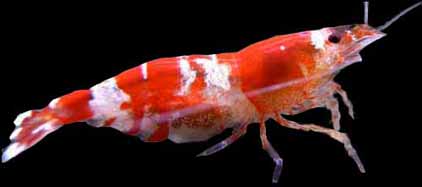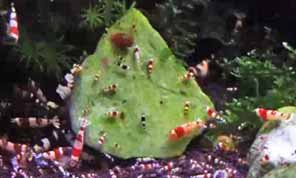Crystal Red Shrimp; by: http://aquariuminfo.org/crs.html
Crystal Red Shrimp
are a rare and unusual shrimp which reportedly came from a mutation
from the black bumble bee shrimp in Japan. Years of inbreeding have
resulted in a very fragile shrimp that is not the same as Cherries.
This shrimp requires near perfect water qualities and is very fussy.
They may seem impossible but let me tell you, there not. Knowledge is
the key here, once you have a basic understanding i.e. reading this
guide, you will easily be able to tackle these shrimp and know what you
are doing. It is people who do not have the knowledge and attempt to
keep such creatures that end up in strife and with dead shrimp. 
We can also see that these shrimp are quite fragile due to the high market price which they command, of course this is also due to the fact of their scarcity and they take longer to breed and produce young then most kind of shrimp.
Crystal Red Shrimps have fairly specific water requirements
- Around 22-25 degrees (70°F-78°F) is perfect temperature for these shrimp. This is slightly lower than cherries; this is why it is not a great idea to have them both in the one tank. One will thrive and the other will suffer.
- The PH should once again be slightly lower
6.2 – 7.2 will be fine with 6.8 being perfect. Plant substrates such as
ADA Amazonia and UpAqua have buffers in them that will not cloud the
water and will keep the ph around 6.8. These products are very popular
with CRS.

- The general hardness should be around ~6-8. TDS should be at about 200, there are products that buffer this. The shrimp prefer slightly harder water so it is important to follow their requirements.
- The carbonate hardness or KH does not affect the shrimps although it may govern the PH and the change in PH with addition of CO2
- The nitrates should be as low as possible but anything under 20ppm is fine.
- Nitrite and ammonia obviously at 0, any hint of either of these and you should not be keeping CRS, they need perfect water.
Unlike Cherry shrimp I would not recommend any tank mates with these rare beauties. They reproduce much slower and the offspring are worth precious dollars. They should be solely kept in a tank by themselves with plenty of places to hide and swim but also a clean environment.
Crystal Red Shrimp come in many different grades and forms. There
 price
increases at an exponential rate as the quality of shrimp goes up. The
grades are C, B, A, S, S+, SS, SSS. There are also a few different
‘types’ within the separate grades. The most common question is “if I
breed an SSS with another SSS do I just get SSS offspring? Well yes and
no. From experience if you have two of the higher grades breeding with
each other, there are higher chances of better offspring. This is not
to say they will all be better or the same, usually a fair few do not
show up with as gooder qualities as the parents and are culled. It is
also a misconception that you can’t get better grades e.g. breeding an
A and an A cannot give you an SS. This is trash, there is less chance
of getting a higher grade but let me tell you it is very much possible,
I feel it is highly based on luck and partly the parents genes. Once
two of my A grade shrimp bred together and produced Two Hinomaru (SS) type and a few A’s.
price
increases at an exponential rate as the quality of shrimp goes up. The
grades are C, B, A, S, S+, SS, SSS. There are also a few different
‘types’ within the separate grades. The most common question is “if I
breed an SSS with another SSS do I just get SSS offspring? Well yes and
no. From experience if you have two of the higher grades breeding with
each other, there are higher chances of better offspring. This is not
to say they will all be better or the same, usually a fair few do not
show up with as gooder qualities as the parents and are culled. It is
also a misconception that you can’t get better grades e.g. breeding an
A and an A cannot give you an SS. This is trash, there is less chance
of getting a higher grade but let me tell you it is very much possible,
I feel it is highly based on luck and partly the parents genes. Once
two of my A grade shrimp bred together and produced Two Hinomaru (SS) type and a few A’s. The Shrimp will constantly moult; do not take out the shells as these provide much needed calcium in their diet when they later consume it. Mosura foods and additives are the current craze at the moment. I do not use these and still get fantastic results but apparently they are meant to help with growing and breeding the shrimp (not the wallet!).
Breeding:
If you keep the temperature and water conditions perfect, females will soon become swollen with eggs. This is good, but it is often that the eggs will disappear suddenly and there will not be any shrimplets. The baby shrimp need very good water quality when born and also places to hide. Remove any fish as the babies are an easy snack. At this stage it is best to use an air driven filter because the tiny baby shrimp cannot be sucked up. Within about 4-5 weeks they should reach adulthood and be able to breed themselves.
Free Template Blogger collection template Hot Deals BERITA_wongANteng SEO theproperty-developer

0 comments:
Post a Comment